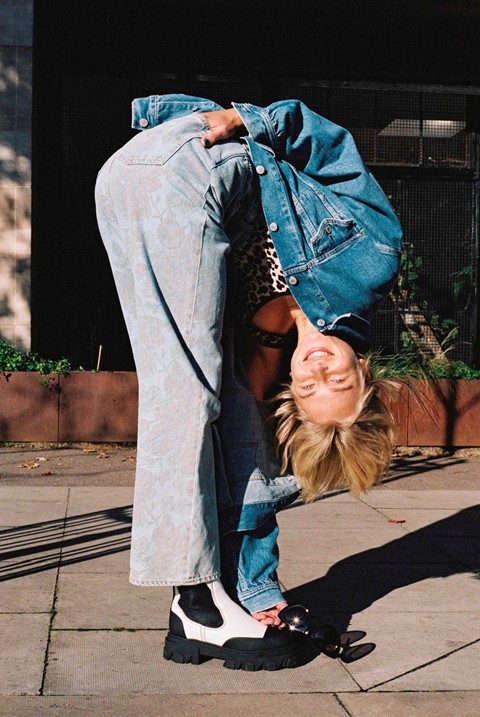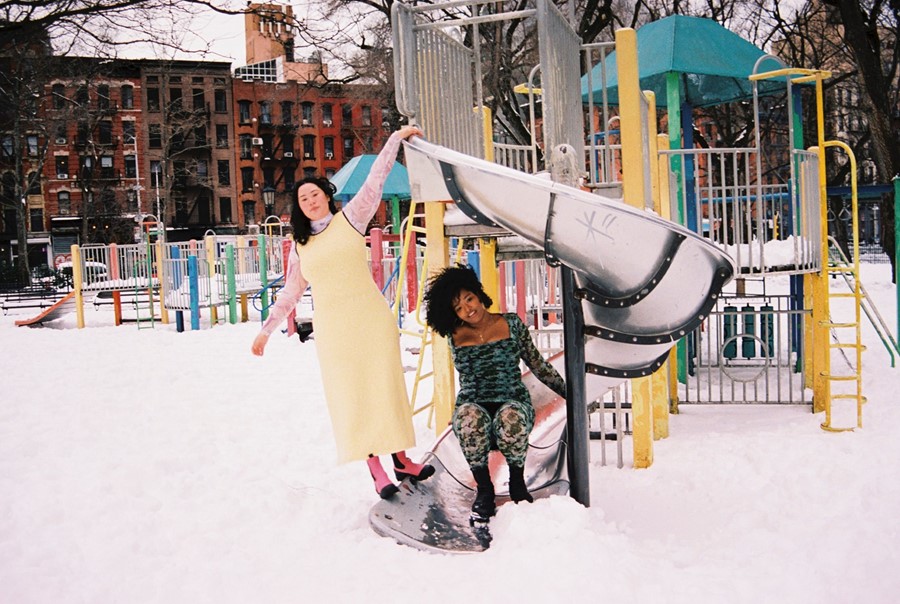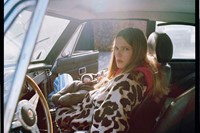Ganni’s Ditte and Nicolaj Reffstrup speak on consumption, confidence, and their Rizzoli-published debut monograph, Gimme More
Husband and wife duo Ditte and Nicolaj Reffstrup took the helm of Danish brand Ganni just over a decade ago, transforming it from an innocuous cashmere label into an international success story. The creative director and founder, respectively, turned the perception of ‘Scandi cool’ on its head, throwing minimalism to the wind and designing clothing with a playful and unapologetic edge.
Today, Ganni needs little introduction. Its price point, hitting the ‘sweet spot’ between high street and high end, means that its very wearable clothing is accessible in more ways than one. Consequently, its loved all over the world by #GANNIGIRLS, as friends of the brand are collectively known. “This was actually a phrase coined by Helena Christensen and Kate Bosworth during a night out. They met up for drinks and they were twinning,” explains Nicolaj Reffstrup of the hashtag’s origin story. “They wore the same Ganni coat. Helena posted an image on Instagram of them wearing the coat, with the hashtag, and we picked up on it and ran with it. I still owe her a beer for that!”
It’s this ‘anything goes’ collaborative attitude, with an emphasis on having fun, that has also paved the way for Ganni. Whilst many fashion brands have a tendency to overcomplicate, this one proves it doesn’t have to in order to triumph. Last month, the Reffstrups launched their debut monograph with Rizzoli titled Ganni: Gimme More, featuring contributions from Ana Kras, Rosie Marks, Susie Lau, Richie Shazam and more. Here, AnOther catches up with the duo to talk ‘responsibility’ not ‘sustainability’ and, of course, the staple of the Ganni way of life: partying.

Hannah Tindle: First of all, congratulations on the launch of your new book. Why did 2021 feel like the right moment to debut it?
Nicolaj Reffstrup: We could come up with an amazing retrospective explanation as to why we ended up doing it in 2021. But quite honestly? I think a lot of things just … happened. You know, it just comes to you and then you do it if it feels right. And that’s very much the story of Ganni. So, when Rizzoli approached us and asked us if we wanted to do a book with them we were flabbergasted. People don’t often ask you if you want to write a book; so we were like ‘let’s do it’.
Ditte Reffstrup: It’s the same as when people ask us: “what is your strategy behind your Instagram?” I’d say there was no strategy. It happened organically, and suddenly it was such a big thing; such a big part of our business. That being said, the lockdown and the pandemic, I had the time to reflect a little bit about the last ten years (which have been crazy). Working so much, with three kids … It’s been a crazy ride. In a way it makes sense. It was not our plan, but it felt like the right moment because we had the time to reflect on everything.
NR: We consider ourselves “insecure overachievers.” We’re always a little insecure about whether we’re doing well enough, and then overcompensate by working even harder. It’s the kind of person you’d love to have on your team, but it’s hard to be that person because you never stop and reflect or appreciate what you’ve been doing. I think if Rizzoli had approached us five years ago we would have declined, because we wouldn’t have the guts to produce a book about Ganni. But after ten years it felt like we had enough of a story to tell that we feel confident enough doing it.
“We consider ourselves ‘insecure overachievers.’ We’re always a little insecure about whether we’re doing well enough, and then overcompensate by working even harder” – Nicolaj Reffstrup
HT: The book is titled Gimme More. Could you explain why you chose this title?
DR: The title is Gimme More: Confidence, Community Responsibility. They encompass the main focus area of Ganni. And it’s fun.
NR: Although it’s been a hard ten years, it’s also been a lot of fun, and we’ve met some awesome people in the process. We just want more of it. It’s very much aligned with our brand DNA that we try to be inclusive. We never try to create a brand or product that’s only for a very few elite fashionistas – we want more.
HT: Confidence, Community Responsibility – can you go into more detail here?
DR: Sure. I’ll start with ‘Confidence’. For me, that is one of the things that I love about fashion. I’m the youngest of three girls, and I was always the one dressing my mum and my sisters up. I also used to work in retail when I was 14, and very early on I learnt how you could actually make people feel better about themselves through clothing. I still have people approach me today saying, “hey Ditte, do you remember when you sold me that amazing dress?” That was my way into fashion – I simply loved dressing people up. It’s a natural thing for me, and why fashion remains fun and relevant.
HT: Let’s talk about ‘Responsibility’. It ties in with the essay in the book The World Doesn’t Need More Clothes, which is a bold statement for a fashion brand to make.
NR: I’ll try to narrow myself down here. This all started when I was studying philosophy and economics 25 years ago. I was studying game theory, which is a mathematical way of describing human behaviour. It describes humans as being extremely opportunistic, although the overall outcome is for the worst for all of us. In parallel with that, I was also studying very early attempts at three-dimensional auditing, where you not only look at the financial performance of the company, but also how you perform to your stakeholders, people, and the planet. Through that, I read a lot about climate change.
I combined those two things and I thought … We’re never gonna solve this. Because we, as humans, won’t sacrifice short term convenience for long term well-being. We’re simply not capable of doing that. I ended up in the fashion industry by coincidence, and from very early we’ve tried to behave responsibly. Not sustainably – no fashion brand is sustainable. But we try to be responsible in our approach to how we leave the world behind us. The first major step is acknowledging that you are not sustainable, because you live off raw consumption. You live off of newness. You need to be transparent about where you are, and hopefully you can make some progress.

HT: That is a very realistic approach. What about ‘Community’? How did you select and approach the Ganni collaborators for this book?
NR: Ganni has always been a team effort; that’s how we’ve handled and conquered creative processes. As a natural extension of that, we’ve always been about creating a community around what we did. Our parties, for example. That’s obviously also a natural extension: inviting people to join us.
DR: It’s always been super easy. A lot of the contributors to the book, for example, have become part of the Ganni family, and personal friends. It’s people we have been working with across seasons and through many years.
HT: Ganni is known for its parties. What do you have planned for the first one, post-pandemic?
DR: I hope we’ll manage to do a classic Ganni party soon. That’s one of the things I’ve missed the most: seeing people hang out and have fun and have a good laugh.
NR: As a couple we used to throw a lot of parties. We always had dinners going on, even when we lived in a tiny apartment. We carried on doing the same with Ganni. Quite early on, we’d have dinners during fashion week, and we’d invite a few friends. In the beginning, we were just sharing pizzas. We never realised how that was a little bit unique, especially when we started bringing international people to Copenhagen fashion week, and we’d invite them home for dinner. It would end up being a party with 300 people at its peak, just before the lockdown. I’m hoping we can continue this, although the 300 people at home won’t work out for us anymore … The last party we had was at the office and we annoyed the neighbours too much!
Ganni: Gimme More is out now, published by Rizzoli.






